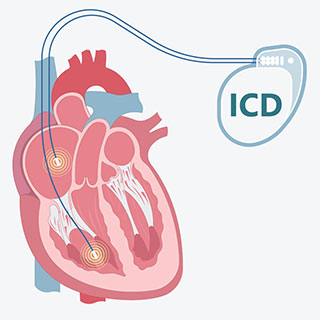Understanding Implantable Cardioverter Defibrillators (ICDs)
If you have – or are deciding whether to have – an implantable cardioverter defibrillator (ICD) placed, it’s important to learn about the device and ask questions.
What is an ICD?
 An ICD is a small, battery-powered device about the size of a small bar of soap. It is used to monitor your heartbeats and correct for a dangerous heart rhythm. It is surgically placed under the skin through a small incision in your chest near your heart. One or more wires (called “leads”) pass through the blood vessel to connect the ICD to the heart. Another type of ICD is called a subcutaneous ICD. This ICD has the same parts as the regular ICD and is inserted under the skin near the heart, but the lead does not go into the heart.
An ICD is a small, battery-powered device about the size of a small bar of soap. It is used to monitor your heartbeats and correct for a dangerous heart rhythm. It is surgically placed under the skin through a small incision in your chest near your heart. One or more wires (called “leads”) pass through the blood vessel to connect the ICD to the heart. Another type of ICD is called a subcutaneous ICD. This ICD has the same parts as the regular ICD and is inserted under the skin near the heart, but the lead does not go into the heart.
An ICD can detect a dangerous heart rhythm – one that could cause the heart to suddenly stop beating (called sudden cardiac arrest). When the ICD senses this dangerous heart rhythm, it responds by giving the heart an electrical shock. This resets the heart to beat normally again.
An ICD is different from a pacemaker. A pacemaker is constantly working to help the heart maintain a normal heart rate. Some ICDs also have a pacemaker built in.
Who might need an ICD?
An ICD can help lower the chance of dying early from a dangerous heart rhythm. Certain heart conditions make this type of rhythm more likely.
You might be offered an ICD if you have a higher chance of having a dangerous heart rhythm that could cause you to die suddenly, possibly at an early age. Some conditions may include:
| Heart failure, when your heart is too weak to pump enough blood for the body, which can lead to rhythm problems | Rare heart conditions:
| Already received a shock by an external defibrillator to restart your heart |
Talk openly with your health care team to make sure you understand why you are being offered an ICD.
Whether or not you have an ICD placed is your choice. For some people, it’s a fairly easy decision. For others, it’s a harder decision. Your health care team should discuss the benefits and possible harms. As part of the decision-making process, be certain to share your goals and wishes for your care, including whether or not you are okay with having a procedure to lower your risk of having a dangerous heart rhythm.
- Last Edited 11/21/2024
Featured Decision Tools
CardioSmart is supported in part by Medtronic.
